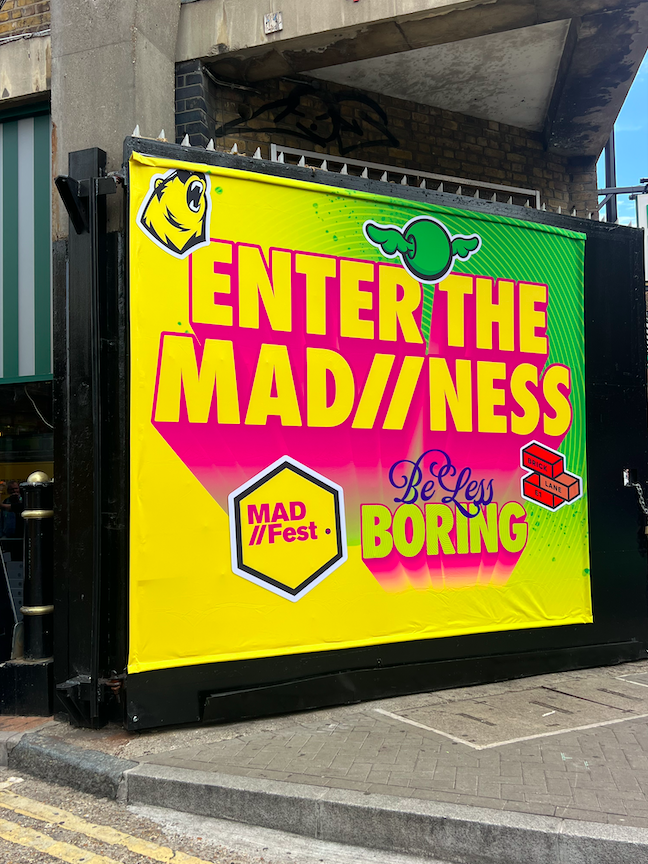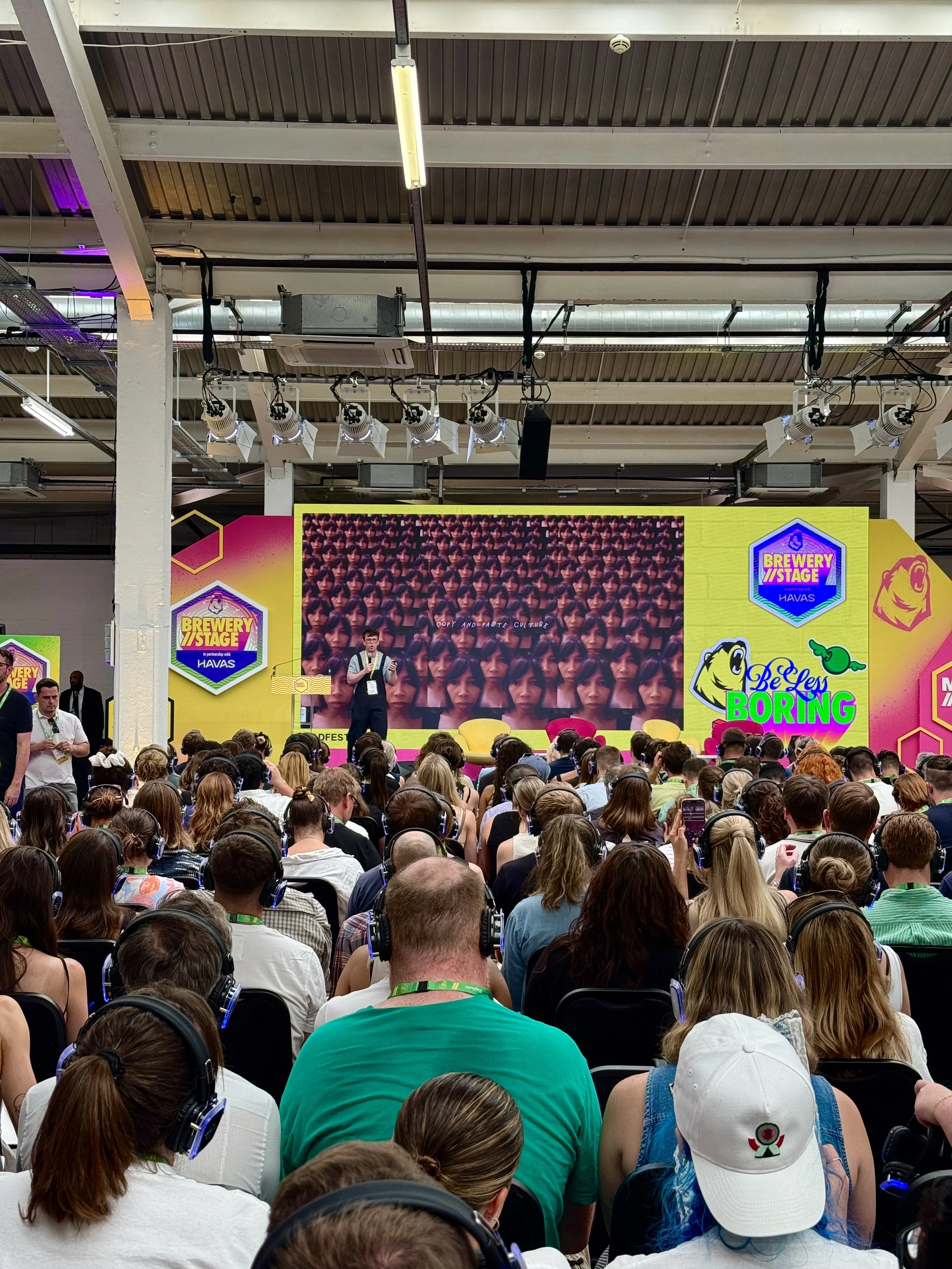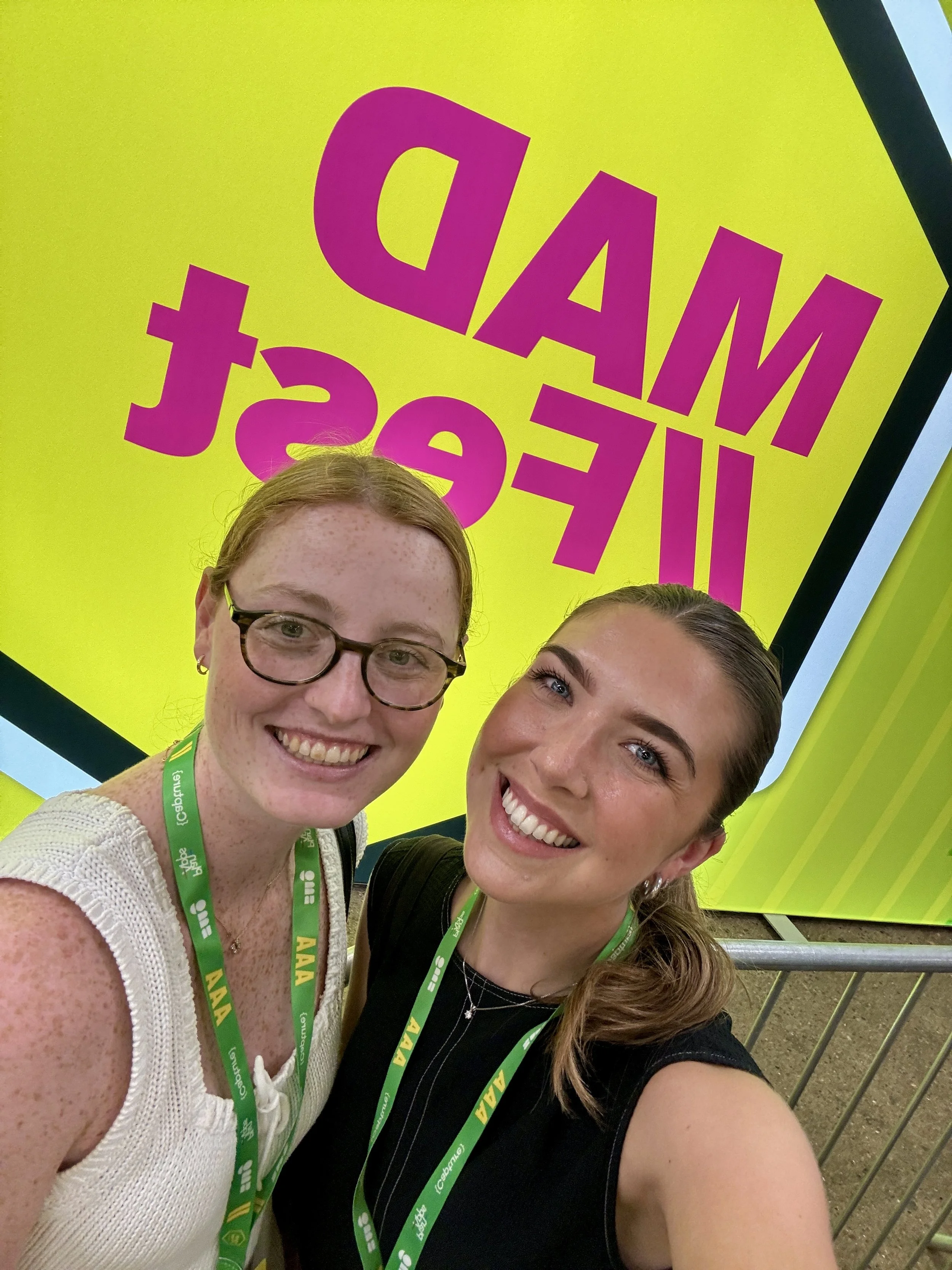MAD//Fest 2025 – big, bold and a bit bonkers. Just how we like it.
Last week, Kate and I swapped our desks in Southwark for shipping containers in Shoreditch and dived headfirst into MAD//Fest, the UK’s biggest, buzziest and boldest marketing bash.
Three days of chaos, charisma and creative overload. We were there for days 1 & 2 (1st and 2nd July), soaking it all in. Here’s the stuff that stuck. The stuff that made us think. The stuff that got under our skin in the best way. We left wired, wide-eyed and full of ideas.
DAY 1: Brands that lead don’t wait for permission.
One of the biggest questions of the day was: “Can brands lead, or will they forever be followers?”
Dirujan Sabesan, CMO of Wingstop, definitely thinks they can (and should). He thinks brands should stop paying to be in places that don’t make a difference. Start creating your own opportunities. That’s where integrity lives. That’s where purpose shows up. Consistency and foresight rather than bandwagons and borrowed relevance.
He talked about showing up in unexpected spaces, especially those that challenge the norm. It's not about being seen everywhere, it’s about being felt somewhere. That might mean community-driven campaigns, seriously good merch (read: stuff people actually want to use), or curating music events that feel less like brand spam and more like cultural contribution. It’s not about product placement. It’s about being part of the place.
From there, it got existential.
“Brain rot is rotting brands.” Paul Hewitt didn’t hold back. His session took aim at the endless churn of copy-paste culture. Brands mimicking brands, peddling the same meme formats and reactive social stunts until everything starts to blur into beige. The result? Forgettability and a generation of consumers who can sniff out inauthenticity a mile off.
He was clear: Think bigger than reactive brain rot content. People want substance. They want stories. They want things that matter.
The real mic-drop moment? “Social is becoming an ick.”
And you know what? He’s right. The scroll is soulless. But that creates a golden window and a chance to reset the rules. Forget the vanity metrics. Ditch the dopamine hits. Hewitt championed a return to storytelling and long-form content, not as nostalgia, but as a strategy. Sure, short-form might get you numbers. But long-form? That gets you loyalty. Two minutes of someone’s attention is worth more than two million impressions they barely noticed.
Then came the legend: Rory Sutherland. Big brain energy. No slides, no script, just pure behavioural science gold. His rallying cry? “Win with brains, not budget.”
For challenger brands, it's all about mindset. You don’t need to dominate the market, you just need to find your critical mass. Pizza Express once had the monopoly on Peroni and San Pellegrino. That’s not a coincidence, it’s a strategy. Get seen, get heard, then herd follows. Find your foothold and let the ripple effect do its thing.
We were introduced to Herdify, an offline social influence app. Because we’re herd animals (even if we’d rather pretend otherwise). We copy habits. We take cues from our circles. Smart brands tap into that, rather than throwing money at mass saturation.
As Rory put it: “We are a herd species, desperately trying not to be.” One of the best lines of the day. Also weirdly comforting.
Meanwhile, Olivia Mitchell-Bent from Drip Water showed us how brands can make their presence felt in real-world spaces without falling into the usual traps. Festivals. Run clubs. Community-led collabs.
Drip isn’t your typical sports drink, but that's the point. By partnering with Run Clubs, they’re repositioning themselves as a lifestyle brand. Less about fuelling workouts, more about fuelling connection. Again, it’s that theme of creating your own space rather than paying to appear in someone else’s.
We finished Day 1 with Sophie Willett from the Department for Culture, Media and Sport, talking about influencers, but not the airbrushed, algorithm-chasing kind. This was about influencers in unlikely places.
Think trusted voices within real communities. People who actually live the message they’re putting out. When it’s done well, the power of co-creation is undeniable. Building credibility, emotional connection, and unlocking audiences that don’t even know they’re audiences yet.
Sophie reminded us: it’s not about numbers. It’s about fit. Big reach is pointless if the content doesn’t hit. Micro-influencers might not have follower counts in the millions, but they’ve got something far more valuable: trust.
DAY 2: When brands stop talking and start backing.
Day 2 took a turn in the best way. Less about noise, more about meaning. Less about marketing gimmicks, more about using platforms to do something that really matters.
The panel on Rugby Reimagined: How Women’s Rugby World Cup 2025 Is Ripping Up the Rulebook hit differently. Maybe because we work with Asahi, or maybe because it was just that good. Either way, this wasn’t just another brand activation story. This was about what happens when partnership, purpose and culture genuinely align.
The panel brought together some big hitters: Ross Curle (Havas Play), Leili Rees-Evans (Asahi), Sally Horrox (World Rugby), and former England international Shaunagh Brown. All talking candidly about how women’s rugby and Asahi’s role in it is rewriting the script.
More tickets have already been sold for WRWC 2025 than for the last tournament in New Zealand. Why? Because awareness is finally catching up. Because women’s sport is finally getting seen and, crucially, getting taken seriously.
For Asahi, this is more than a logo-on-the-shirt kind of sponsorship. A brand putting its money where its mouth is, with a partnership designed to do more than tick a box. The WRWC gives Asahi something powerful: relevance, purpose, passion. And in return, Asahi is giving the game something it badly needs: visibility.
There’s a cultural shift happening here. This isn’t men’s rugby, chasing scale and dominance. This is a different energy entirely. It’s inclusive. It’s full of grit. It’s emotional. It’s human. Shaunagh Brown summed it up with her story; she only started playing rugby at 25. Two years later, she was a professional. That simply wasn’t an option just a decade ago. Now, it’s a career path. A real one.
This is the power of the partnership. It’s not just about slapping your brand on a jersey; it’s about backing the values. Asahi’s campaign "Rugby Like Never Before" is grounded in visibility, authenticity, and connection. And it shows.
The work feels fresh and intentional. A hero film that launched at MAD//Fest, a podcast went live the very next day, and even a prize draw on-pack to create a tangible link between beer and game-day buzz. But the standout idea? The Pub Pledge. Getting pubs across the country to screen WRWC games, making sure fans can watch the sport they love, in the places they already gather. It sounds simple, but it’s a big deal. Visibility isn’t just a media plan, it’s a movement. “People care more about sport than they do about beer.”
That was Leili Rees-Evans being brilliantly honest. And absolutely right. Sport has heart. Sport has power. And for brands like Asahi, tapping into that energy isn’t just good marketing, it’s good business.
If Day 1 asked whether brands can lead, Day 2 showed us how they actually do.
If it doesn’t make you feel something, what’s the point?
From brain rot to behavioural science, micro-influencers to macro cultural shifts, MAD//Fest reminded us that the best brands aren’t chasing, they’re creating.
Lead, don’t follow. Show up where it matters.




